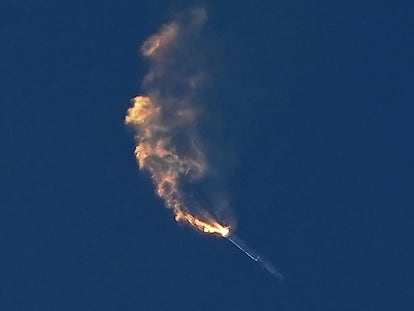Why did ‘Starship’ explode? The reasons behind the failed launch of Elon Musk’s rocket
The powerful SpaceX spacecraft, capable of going to the Moon and Mars, exploded when its two modules attempted to separate
The long-awaited launch of the huge Starship rocket ended in an explosion over the Gulf of Mexico, but SpaceX considers it a learning experience rather than a failure. It was an initial test flight and more will follow. The failure occurred during the stage separation process. The first stage separated successfully after the critical max-q point, where aerodynamic pressure intensifies, stressing the rocket inordinately. The rocket achieved this, although six of its 33 engines shut down shortly after liftoff, which shows the capacity and resilience of the spacecraft.
What happened?
The rocket that exploded is actually two components: the first stage is the Super Heavy booster rocket used to propel the second stage — the Starship spacecraft — into orbit. To separate from the Super Heavy rocket, Starship does not use an active mechanism like other rockets. It simply unscrews itself (like twisting off a bottle cap) to open the connection clamps and then waits for centrifugal force to force separation. That seems to be the mechanism that failed during this flight test. It was probably the least expected failure point. A rocket explosion, in-flight disintegration and flight path deviation are more common setbacks. No one thought the clamps would fail to open — they had been tested a thousand times over. Shortly after the test, SpaceX CEO Elon Musk tweeted, “Learned a lot for the next test launch in a few months.”
What was the explosion like?
The video feed showed the rocket spinning as intended, but the two stages failed to separate. At this point, the mission control team issued a command to detonate the explosive charges on both stages of the vehicle, between the oxygen and methane tanks. This mixes the two liquids that explode and destroy the rocket, preventing an uncontrolled and dangerous fall to earth. Every launch since the early years of the space race has had a similar safety mechanism. As the Super Heavy booster rocket quickly burned its fuel, the 400-foot (120-meter) Starship could not break free and would have fallen to the ground in one piece, causing significant risk to life and property below.
For SpaceX, a successful liftoff and flight to the required altitude for stage separation was an achievement in itself. Now the job is to learn from this experience, refine the next Starship and conduct more tests. SpaceX engineer John Insprucker, serving as a launch commentator on the company’s webcast, said, “Now this was a development test. This was the first test flight of Starship, and the goal is to gather the data, and as we said, clear the pad and get ready to go again.”
Does it put a Moon landing at risk?
NASA and the European Space Agency’s Artemis project intends to use Starship to land astronauts on the Moon. The Artemis 2 mission, which will take four astronauts into Moon orbit, will fly with the SLS, a rocket developed by NASA and successfully tested with Artemis 1. But the Artemis 3 mission, which plans to land people on the Moon in 2025, will depend on Starship. Even the most optimistic space fans thought this would be impossible by 2025, and this explosion may delay this accelerated schedule.
Congrats @SpaceX team on an exciting test launch of Starship!
— Elon Musk (@elonmusk) April 20, 2023
Learned a lot for next test launch in a few months. pic.twitter.com/gswdFut1dK
Is ‘Starship’ the most powerful rocket ever built?
Yes — it has almost 7,500 tons of thrust and 33 simultaneously firing engines. Until now, the venerable N1 rocket developed by the USSR to go to the Moon held the title, but it failed in its only four launches. The N1 had 4,500 tons of thrust and 30 engines. The current version of NASA’s SLS rocket used to propel the Orion capsule of the Artemis program generates about 4,000 tons of thrust. Until the Starship, it was the most powerful rocket to have flown successfully. The Saturn V, which powered the Apollo missions to the Moon, had only 3,300 tons of thrust. But it’s not all about takeoff power: sometimes less powerful rockets perform better and can send larger payloads into orbit.
Why does it burn methane?
Although the methalox (a mixture of liquid methane and oxygen) rocket fuel used by SpaceX’s Starship is slightly less efficient than the SLS rocket’s liquid hydrogen and oxygen fuel, it’s much simpler to operate. Liquid hydrogen has to be cooled much more than methane, a difficult and expensive process. Methane is less susceptible to leakage and produces less residue than the kerosene used by SpaceX in previous rockets, making it easier to clean the engines after each flight.
Also, let’s not forget that this spacecraft’s ultimate destination is Mars, and Elon Musk believes that methane fuel can be produced from that planet’s natural resources. The Perseverance probe in 2002 conducted a small-scale test of this theory when it collected 200 grams of gas from 30 samples. To be practical, future manned vehicles will have to multiply that by at least a factor of 400.
Is ‘Starship’ reusable?
Yes, both stages of are recoverable and future flights will have them drop into the ocean. Recovering Super Heavy hasn’t yet been tested, but after some spectacular failures a few years ago, a prototype of the second stage reached an altitude of nine miles (15 kilometers) and landed safely on its launch pad.
SpaceX’s Falcon rockets now routinely land safely after boosting their payload into orbit, showing that Elon Musk’s company has mastered the process. Some Falcons have made over 15 flights, making launch economics much more palatable. NASA’s very expensive SLS rockets (like the old Saturn V rockets) can only be used once — a new one has to be built for each launch and none of its components can be recovered.
How much does a ‘Starship’ cost?
In 2019, Musk said the development cost of Starship would be about $3 billion (€2.7 billion), although he hopes to reduce this to $9 million per unit once it can be mass-produced. Each SLS rocket costs about $4 billion.
SpaceX has manufactured seven main rocket boosters and 24 upper units. Most of the latter are test models that were never intended to fly and are used to check various onboard systems and compatibility with launch facilities. Others were launched in tests to perfect vertical landings. More are already under construction.
Where did it take off from?
Starship was launched from Boca Chica, Texas, on the Gulf Coast, just a few miles north of the border. SpaceX built a facility there called Starbase, which has several rocket integration hangars, control and tracking centers, methane and oxygen storage systems and a 490-foot (150-meter) launch tower.
A similar tower is being built at the Kennedy Space Center in Florida, and another one may be forthcoming. After the development phase ends, SpaceX plans to make frequent, perhaps weekly, launches from Starbase.
The success of the Starship program hinges on achieving a rapid orbital launch rotation with reusable rockets. The launch tower has a crane to assemble the two units on the support pedestal. After liftoff and separation, the first stage performs a braking maneuver and returns to the launch tower. Two huge grappling arms (SpaceX calls them the “chopsticks”) catch the rocket and sets it down on the launch pad. The second stage lands vertically on a nearby platform. After both stages haven been recovered, they can be re-assembled, checked out, repaired and refueled for another trip within days. That’s the vision, although this first flight did not plan to attempt recovery maneuvers.
Is it part of the lunar program?
Starship was originally designed to go to Mars. But its enormous payload capacity also makes it useful for sending satellites (hundreds at a time) into low orbit or to travel to other planets.
In April 2021, NASA awarded SpaceX the contract to build the lunar lander for the initial phases of the Artemis program. Three candidates submitted proposals, but SpaceX’s was by far the most cost-effective. It was also the only company to offer a vehicle that had been partially tested.
NASA’s current plan is for three astronauts from the Artemis 3 mission to land on the Moon aboard a variant of the Starship specially designed for that mission scheduled for 2025. The image of such a large lunar lander attached to the small Orion capsule, only slightly larger than the Apollo 50 years ago, will certainly be shocking.
Will the lunar ‘Starship’ return to Earth after landing on the Moon?
No. The lunar version is a one-way spacecraft. After it lands on the Moon, it will remain anchored there. The astronauts will return to Earth in the Orion capsule, which may be used in future Moon landings after a checkout and refueling (theoretically).
The big question is whether Starship’s lunar module will be ready in a couple of years. The refueling process, essential for the one-way trip to lunar orbit, has not been tested. In fact, no one has even seen a prototype beyond the illustrations released by SpaceX.
NASA expects the lunar Starship will make an uncrewed flight late next year. Just one. Amid the space race frenzy 50 years ago, the lunar module was tested three times (twice with astronauts on board) before Apollo 11 launched. The Artemis 3 lunar landing is currently scheduled for December 2025, but many experts think making that deadline will be nothing short of miraculous.
Sign up for our weekly newsletter to get more English-language news coverage from EL PAÍS USA Edition
Tu suscripción se está usando en otro dispositivo
¿Quieres añadir otro usuario a tu suscripción?
Si continúas leyendo en este dispositivo, no se podrá leer en el otro.
FlechaTu suscripción se está usando en otro dispositivo y solo puedes acceder a EL PAÍS desde un dispositivo a la vez.
Si quieres compartir tu cuenta, cambia tu suscripción a la modalidad Premium, así podrás añadir otro usuario. Cada uno accederá con su propia cuenta de email, lo que os permitirá personalizar vuestra experiencia en EL PAÍS.
¿Tienes una suscripción de empresa? Accede aquí para contratar más cuentas.
En el caso de no saber quién está usando tu cuenta, te recomendamos cambiar tu contraseña aquí.
Si decides continuar compartiendo tu cuenta, este mensaje se mostrará en tu dispositivo y en el de la otra persona que está usando tu cuenta de forma indefinida, afectando a tu experiencia de lectura. Puedes consultar aquí los términos y condiciones de la suscripción digital.
More information
SpaceX calls off launch of Starship
Archived In
Últimas noticias
The United States designates Clan de Golfo as a foreign terrorist group
The United States strikes three more suspected drug boats, killing eight
The Iberian Peninsula is rotating clockwise, scientists report
Louis Tomlinson on surviving the loss of his mother, sister and One Direction bandmate: ‘There’s no preparation for what I’ve been through’
Most viewed
- Christian Louboutin: ‘Young people don’t want to be like their parents. And if their parents wear sneakers, they’re going to look for something else’
- ‘We are dying’: Cuba sinks into a health crisis amid medicine shortages and misdiagnosis
- A mountaineer, accused of manslaughter for the death of his partner during a climb: He silenced his phone and refused a helicopter rescue
- Cartels in Mexico take a leap forward with narco-drones: ‘It is criminal groups that are leading the innovation race’
- ‘El Limones’ and the growing union disguise of Mexican organized crime











































